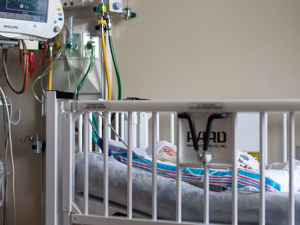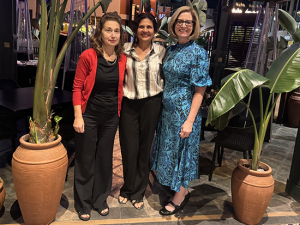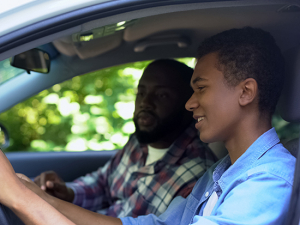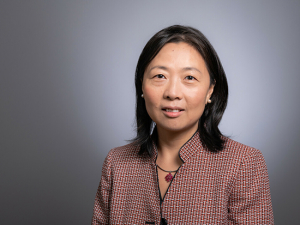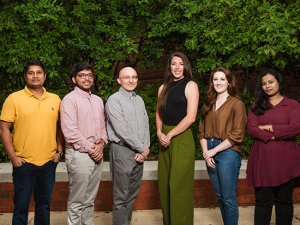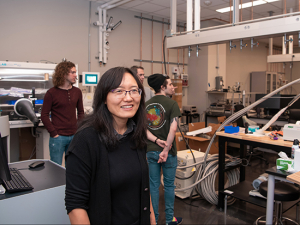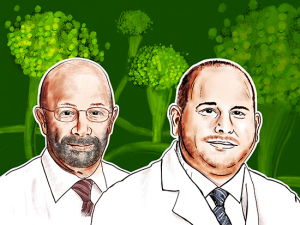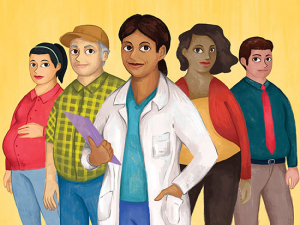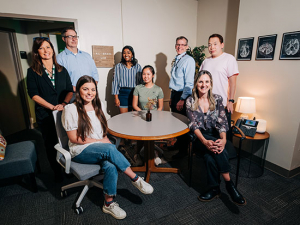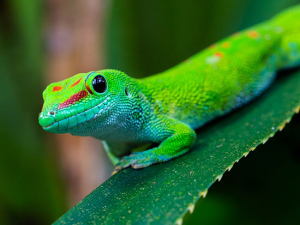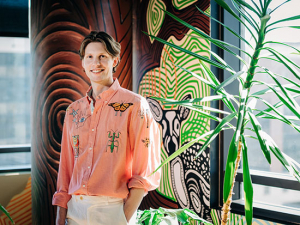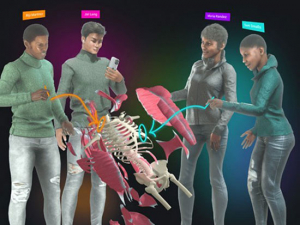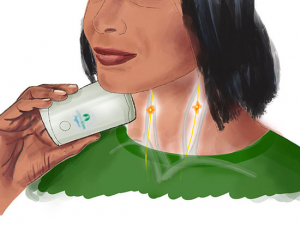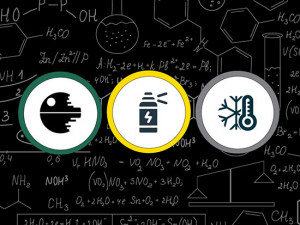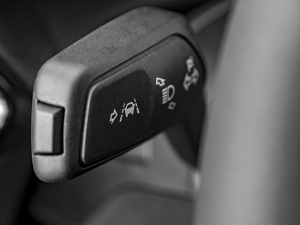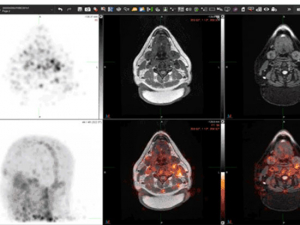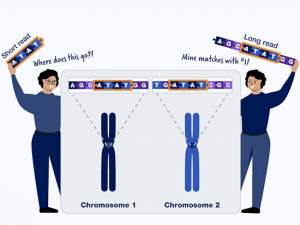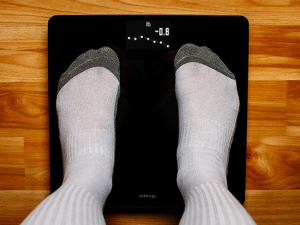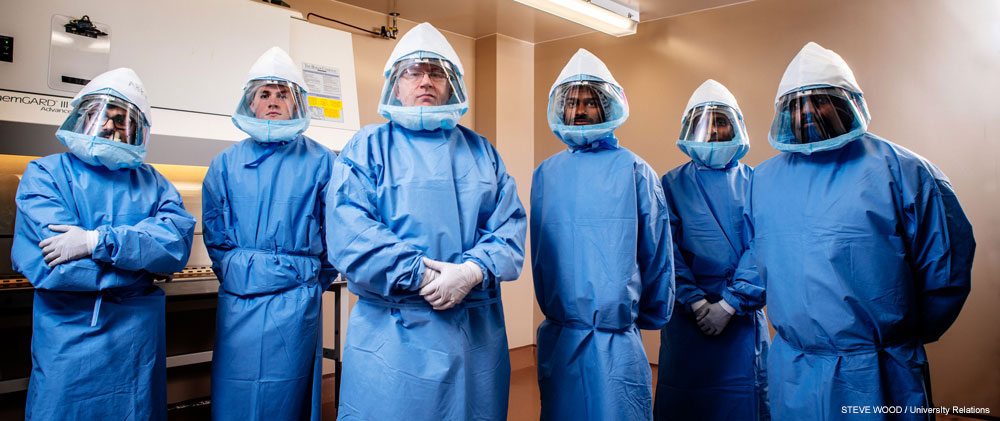 Members of the lab of Andries Steyn, Ph.D., volunteered to assist with crucial COVID-19 research while their own studies of tuberculosis were on hold in the early days of the pandemic. Shown above in their BSL3 containment gear are, left to right: Ritesh Sevalkar, Ph.D., Hayden Pacl, Joel Glasgow, Ph.D., Sajid Nadeem, Ph.D., Vineel Reddy, Ph.D., and Krishna Chinta.No one knew, in fall 2019, that a deadly coronavirus would sweep the globe in the coming months. But at UAB, crucial elements of a response that would draw attention around the world were already in place. Just as important as the expertise and equipment in UAB's labs and classrooms, however, was the university's spirit: UAB prides itself as being an institution without walls, where traditional disciplinary boundaries are no obstacle to pursuing innovative connections.
Members of the lab of Andries Steyn, Ph.D., volunteered to assist with crucial COVID-19 research while their own studies of tuberculosis were on hold in the early days of the pandemic. Shown above in their BSL3 containment gear are, left to right: Ritesh Sevalkar, Ph.D., Hayden Pacl, Joel Glasgow, Ph.D., Sajid Nadeem, Ph.D., Vineel Reddy, Ph.D., and Krishna Chinta.No one knew, in fall 2019, that a deadly coronavirus would sweep the globe in the coming months. But at UAB, crucial elements of a response that would draw attention around the world were already in place. Just as important as the expertise and equipment in UAB's labs and classrooms, however, was the university's spirit: UAB prides itself as being an institution without walls, where traditional disciplinary boundaries are no obstacle to pursuing innovative connections.
On March 25, only a few days after UAB entered its Limited Business Model in response to the spreading pandemic, the School of Medicine and Hugh Kaul Precision Medicine Institute released a request for applications for emergency COVID-19 funding. Five days later, the review committee had 52 applications in hand.
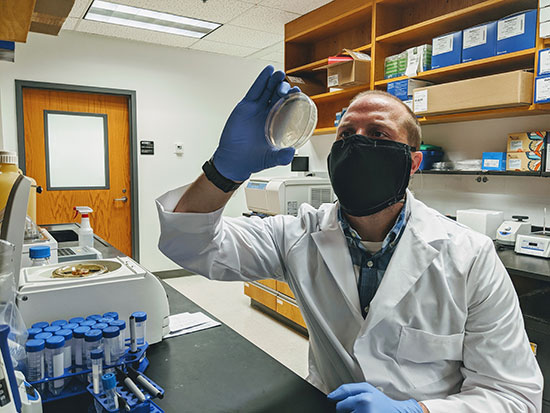 Nicholas Lennemann, Ph.D., in his lab, where he is adapting the fluorescent screening technique he developed for enteroviruses as a postdoc into a new type of test for SARS-CoV-2, the novel coronavirus that causes COVID-19.Nicholas Lennemann, Ph.D., an assistant professor in the Department of Microbiology who was so new to UAB that his lab wasn't even set up, proposed adapting his work on fluorescent tests for enteroviruses into a new way to test for SARS-CoV-2, the virus that causes COVID-19, at a time when critical reagents for the most commonly used tests were in desperately short supply.
Nicholas Lennemann, Ph.D., in his lab, where he is adapting the fluorescent screening technique he developed for enteroviruses as a postdoc into a new type of test for SARS-CoV-2, the novel coronavirus that causes COVID-19.Nicholas Lennemann, Ph.D., an assistant professor in the Department of Microbiology who was so new to UAB that his lab wasn't even set up, proposed adapting his work on fluorescent tests for enteroviruses into a new way to test for SARS-CoV-2, the virus that causes COVID-19, at a time when critical reagents for the most commonly used tests were in desperately short supply.
Randy Cron, M.D., Ph.D., and Winn Chatham, M.D., professors in the Division of Immunology and Rheumatology, received funding for a first-in-the-United-States trial of a drug to treat the cytokine storm syndrome that appeared to be contributing to many fatal cases of COVID-19 — building on previous trials of the same drug to treat cytokine storm syndrome in patients with herpes virus family infections and other conditions.
Benjamin Larimer, Ph.D., assistant professor in the Department of Radiology and O'Neal Comprehensive Cancer Center, proposed a new method of identifying antibodies to attack COVID-19 based on his work on phage display for applications in cancer care.
Troy Randall, Ph.D., and Frances Lund, Ph.D., both professors in the Department of Microbiology (for which Lund is chair), received funding to adapt their world-renowned work on antibody reactions in influenza to create ultra-sensitive tests that would answer critical questions on antibodies to SARS-CoV-2.
Meanwhile, they also were working with Maryland-based Altimmune, a company based on licensed UAB technology, for basic studies of its potentially revolutionary nasal-spray vaccine for COVID-19.
|
As we mark the anniversary of our COVID year, we've highlighted the events of March 2020 and the rapid acceleration of our response to the threat. You can follow the complete timeline of UAB's COVID experience at uab.edu/uabunited/our-covid-year, and read the first story in this Reporter series, Education methods changed overnight and UAB met the challenge head-on. |
Matt Might, Ph.D., director of the Kaul Precision Medicine Institute, and his team were leaning into their specialty, using machine-learning tools to search through tens of thousands of already-approved FDA drugs to find potential new therapies to slow the spread of COVID-19 throughout the body.
This work, and many of the other 24 projects that were ultimately funded in two rounds in the spring and summer by the School of Medicine, depended on working directly with live samples of the SARS-CoV-2 virus. This work was possible in UAB's Biosafety Level 3 labs, thanks to Kevin Harrod, Ph.D., professor in the Department of Anesthesiology and Perioperative Medicine. Harrod, a world expert on SARS viruses, had rapidly established crucial virus reservoirs, even though he was between grants and therefore extremely short-handed in lab staff.
Not to worry, as researchers from the lab of microbiology Professor Andries Steyn, Ph.D., with his blessing, volunteered for the arduous, potentially hazardous work. "Dr. Steyn encouraged us to jump in wherever we could," said Joel Glasgow, Ph.D., assistant professor in the Department of Microbiology.
Steyn's lab, along with all other labs not directly involved with COVID-19 research, was working remotely since the mid-March Limited Business Model went into effect at UAB. By Memorial Day, researchers began to return to their labs, with extensive new cleaning and distancing procedures in place.
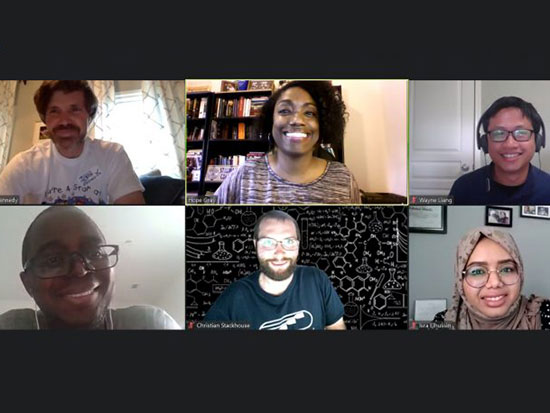 Members of the Blazer Data Wranglers team, who analyzed COVID-19 disease burden and comorbidities in African American patients at UAB during a two-day hackathon in June 2020.Like workers around the world, UAB faculty, staff and students were growing accustomed to the new experience of collaborating remotely by Zoom and other methods. Technology also offered new avenues to attack the coronavirus. In June, researchers in the Informatics Institute convened their first remote hackathon to surge toward novel approaches in COVID-19 research, therapy and public health tools, including a risk-factor-based mapping tool enabling users to plan travel to avoid COVID-19 hotspots and analyses of COVID-19 disease burden and comorbidities in African American patients.
Members of the Blazer Data Wranglers team, who analyzed COVID-19 disease burden and comorbidities in African American patients at UAB during a two-day hackathon in June 2020.Like workers around the world, UAB faculty, staff and students were growing accustomed to the new experience of collaborating remotely by Zoom and other methods. Technology also offered new avenues to attack the coronavirus. In June, researchers in the Informatics Institute convened their first remote hackathon to surge toward novel approaches in COVID-19 research, therapy and public health tools, including a risk-factor-based mapping tool enabling users to plan travel to avoid COVID-19 hotspots and analyses of COVID-19 disease burden and comorbidities in African American patients.
As the disproportionate impact of COVID-19 on minority and under-served populations became clear, several research teams at UAB contributed new insights on the problem. Ramaraju Rudraraju, Ph.D., assistant professor in the Department of Surgery, led a team in the Informatics Institute's COVID-19 hackathon that developed a tool to study how the COVID-19 burden relates to county-level social determinants of health. They kept working on the project and later were finalists in a national data challenge competition sponsored by the American Heart Association with the project.
In-person scientific meetings are the typical venue for sharing discoveries and forging new connections among practitioners. As COVID-19 continued to surge through the summer, conference organizers such as the Informatics Institute's Chief Bioinformatics Officer Jake Chen, Ph.D., developed agendas, technical solutions and other adaptions for re-creating the conference experience online. Similar adaptations were happening in the Graduate School, where students who would normally have defended their doctoral dissertations and master's theses in a room of friends and colleagues took to Zoom instead.
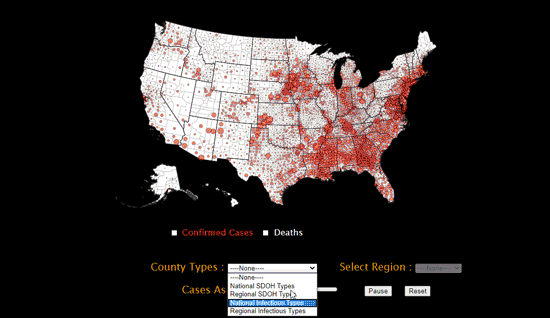 An animated example of one of the visualizations developed by a UAB team that was a finalist in a national data challenge competition sponsored by the American Heart Association. The different colors on counties (purple, green, yellow, etc.) represent different clusters of factors the team has identified in its research as important. The clusters were grouped together using machine learning techniques. Then, as time advances in the animation, from early February to July 2020, the cumulative number of confirmed COVID-19 cases for each county are overlaid on the map.The School of Medicine organized a high-profile research symposium in October to review discoveries made by faculty and look to next steps in research, with keynote speakers Anthony Fauci, M.D., director of the NIH's National Institute on Allergy and Infectious Diseases and Kathleen Neuzil, M.D., director of the University of Maryland's Center for Vaccine Development. Little more than seven months after Alabama and the rest of the country shut down in response to the COVID-19 pandemic, UAB researchers had clearly had an outsized impact on understanding and fighting the disease. The event also foreshadowed the university's coming role in the vaccine stage of the fight against COVID-19. "UAB has been a major player" in COVID-19 vaccine trial design and execution due to the leadership role played by UAB faculty in groups such as the Infectious Diseases Clinical Research Consortium and HIV Prevention Trials Network, Neuzil told the audience.
An animated example of one of the visualizations developed by a UAB team that was a finalist in a national data challenge competition sponsored by the American Heart Association. The different colors on counties (purple, green, yellow, etc.) represent different clusters of factors the team has identified in its research as important. The clusters were grouped together using machine learning techniques. Then, as time advances in the animation, from early February to July 2020, the cumulative number of confirmed COVID-19 cases for each county are overlaid on the map.The School of Medicine organized a high-profile research symposium in October to review discoveries made by faculty and look to next steps in research, with keynote speakers Anthony Fauci, M.D., director of the NIH's National Institute on Allergy and Infectious Diseases and Kathleen Neuzil, M.D., director of the University of Maryland's Center for Vaccine Development. Little more than seven months after Alabama and the rest of the country shut down in response to the COVID-19 pandemic, UAB researchers had clearly had an outsized impact on understanding and fighting the disease. The event also foreshadowed the university's coming role in the vaccine stage of the fight against COVID-19. "UAB has been a major player" in COVID-19 vaccine trial design and execution due to the leadership role played by UAB faculty in groups such as the Infectious Diseases Clinical Research Consortium and HIV Prevention Trials Network, Neuzil told the audience.
“The fact that two prominent national leaders such as Dr. Fauci and Dr. Neuzil were keynote speakers at the UAB COVID-19 Research Symposium speaks not only to the importance and timeliness of the topic but also to the critical role that UAB is playing in the effort to combat this pandemic,” said Christopher Brown, Ph.D., vice president for Research at UAB.
